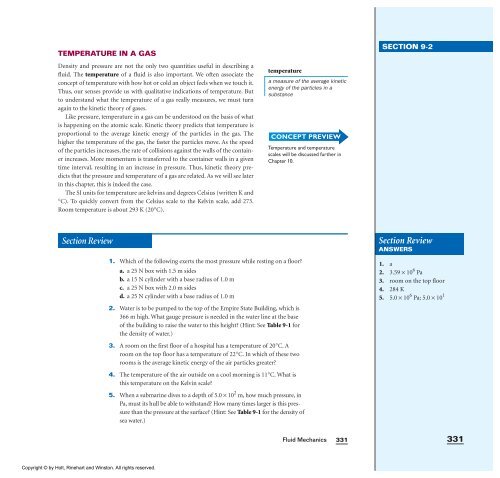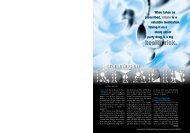Create successful ePaper yourself
Turn your PDF publications into a flip-book with our unique Google optimized e-Paper software.
TEMPERATURE IN A GAS<br />
Density and pressure are not the only two quantities useful in describing a<br />
fluid. The temperature of a fluid is also important. We often associate the<br />
concept of temperature <strong>with</strong> how hot or cold an object feels when we touch it.<br />
Thus, our senses provide us <strong>with</strong> qualitative indications of temperature. But<br />
to understand what the temperature of a gas really measures, we must turn<br />
again to the kinetic theory of gases.<br />
Like pressure, temperature in a gas can be understood on the basis of what<br />
is happening on the atomic scale. Kinetic theory predicts that temperature is<br />
proportional to the average kinetic energy of the particles in the gas. The<br />
higher the temperature of the gas, the faster the particles move. As the speed<br />
of the particles increases, the rate of collisions against the walls of the container<br />
increases. More momentum is transferred to the container walls in a given<br />
time interval, resulting in an increase in pressure. Thus, kinetic theory predicts<br />
that the pressure and temperature of a gas are related. As we will see later<br />
in this chapter, this is indeed the case.<br />
The SI units for temperature are kelvins and degrees Celsius (written K and<br />
°C). To quickly convert from the Celsius scale to the Kelvin scale, add 273.<br />
Room temperature is about 293 K (20°C).<br />
Section Review<br />
Copyright © by Holt, Rinehart and Winston. All rights reserved.<br />
temperature<br />
1. Which of the following exerts the most pressure while resting on a floor?<br />
a. a 25 N box <strong>with</strong> 1.5 m sides<br />
b. a 15 N cylinder <strong>with</strong> a base radius of 1.0 m<br />
c. a 25 N box <strong>with</strong> 2.0 m sides<br />
d. a 25 N cylinder <strong>with</strong> a base radius of 1.0 m<br />
2. Water is to be pumped to the top of the Empire State Building, which is<br />
366 m high. What gauge pressure is needed in the water line at the base<br />
of the building to raise the water to this height? (Hint: See Table 9-1 for<br />
the density of water.)<br />
3. A room on the first floor of a hospital has a temperature of 20°C. A<br />
room on the top floor has a temperature of 22°C. In which of these two<br />
rooms is the average kinetic energy of the air particles greater?<br />
4. The temperature of the air outside on a cool morning is 11°C. What is<br />
this temperature on the Kelvin scale?<br />
a measure of the average kinetic<br />
energy of the particles in a<br />
substance<br />
CONCEPT PREVIEW<br />
Temperature and temperature<br />
scales will be discussed further in<br />
Chapter 10.<br />
5. When a submarine dives to a depth of 5.0 × 10 2 m, how much pressure, in<br />
Pa, must its hull be able to <strong>with</strong>stand? How many times larger is this pressure<br />
than the pressure at the surface? (Hint: See Table 9-1 for the density of<br />
sea water.)<br />
<strong>Fluid</strong> <strong>Mechanics</strong><br />
331<br />
SECTION 9-2<br />
Section Review<br />
ANSWERS<br />
1. a<br />
2. 3.59 × 10 6 Pa<br />
3. room on the top floor<br />
4. 284 K<br />
5. 5.0 × 10 6 Pa; 5.0 × 10 1<br />
331
















